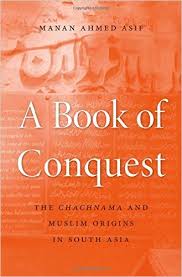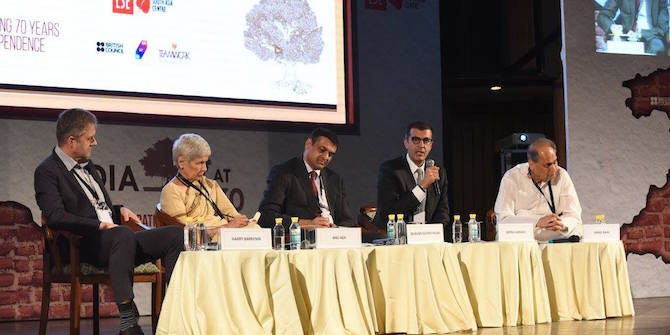 A Book of Conquest: The Chachnama and Muslim Origins in South Asia is a critical literary, historical and intellectual analysis of a 13th century Persian text which tells the story of the Arab invasions of Sindh in the 7-8th centuries. Asad Abbasi finds the book an important re-examination of a key text which has been used to perpetuate the myth that Hindus and Muslims are historic enemies, despite offering a moral conduct for governance.
A Book of Conquest: The Chachnama and Muslim Origins in South Asia is a critical literary, historical and intellectual analysis of a 13th century Persian text which tells the story of the Arab invasions of Sindh in the 7-8th centuries. Asad Abbasi finds the book an important re-examination of a key text which has been used to perpetuate the myth that Hindus and Muslims are historic enemies, despite offering a moral conduct for governance.
A Book of Conquest: The Chachnama and Muslim Origins in South Asia. Manan Ahmed Asif. Harvard University Press. 2016.
Introduction
 Every origin story about Muslims in South Asia borrows something from the Chachnama, a thirteenth Century Persian manuscript authored by a settler in Uch, Sindh, named Ali Kufi. Kufi claimed his work was a translation an Arabic manuscript with historical narratives about Sindh in the seventh and eighth centuries.
Every origin story about Muslims in South Asia borrows something from the Chachnama, a thirteenth Century Persian manuscript authored by a settler in Uch, Sindh, named Ali Kufi. Kufi claimed his work was a translation an Arabic manuscript with historical narratives about Sindh in the seventh and eighth centuries.
It is the Chachnama that is cited when the ‘foreignness’ and savagery of Muslims is narrated by Hindu nationalists in India. It is Chachnama that is quoted when forgiveness and benevolence of Muslims is written by state historians in Pakistan. And poor old Chachnama was the reference point for writers of the British Empire in eighteenth and nineteenth century to explain the barbarism and destruction by Muslims.
Manan Ahmed Asif’s A Book of Conquest is a critical literary, historical and intellectual analysis of this historical text. The title is a perfect example of verbal irony, because Asif’s central argument is that the Chachnama is not a book of conquest.
Not a book of translation; neither a conquest narrative
Ali Kufi’s narrative begins with rise of Chach of Alor from a letter writer to King of Sindh. After Chach’s death his son, Dahar inherits the Kingdom and rules until his defeat by Umayyad General Muhammad Bin Qasim. Chachnama ends with Bin Qasim killing himself on the orders of the Caliph.
Asif implies that previous commentators have invariably selected, chopped, derided, ridiculed, and ignored parts of the text to fit their own agendas. But there are two common assumptions that still hold, primarily because of how Ali Kufi frames his work: first, the Chachnama is a translation of an Arabic manuscript, and second it is a book about conquest in eighth century Sindh. Asif rejects both these assumptions. He argues the Chachnama is an original book of political theory written in Persian addressed to the audience of thirteenth century Sindh.
Asif builds on work by Muzaffar Alam and A.C.S. Peacock in challenging the notion that the text is a translation. Alam, an eminent Mughal historian, proposes that translation was key part of ‘Persianisation’ i.e. process for the elites to move away from religious values towards more secular methods (p. 55). Peacock, Professor of History at St Andrews, views the translations of that period as ‘transcreations or commentarial interpretations’. Asif highlights that in the 13th century claiming a book’s Arabic heritage was customary but also very prudent for raising author’s profile. Kufi’s contemporaries such as Awfi and Juzjani are known to have employed similar methods. The historians of thirteenth century may call their own work translations but ‘saw pedagogy and self-reflection as key function of the texts’ (p. 60).
Asif also argues that the Chachnama does not fit the mould of other conquest narratives within Arabic historiography. These differences are stark: while the conquest narrative deals in proper names; the Chachnama gives ‘general attributes’ and uses generic citations (p. 63). The Arabic conquest literature focuses on plot of the story, description of land and regions; Kufi, instead, writes about ‘inner turmoil, deliberation, doubts and planning of the campaign’. The conquest narratives paint dismal picture of pre-Islamic times; Chachnama informs the reader of the wealth and resources in Sind before Muhammad Bin Qasim. Furthermore, unlike the conquest narratives, Kufi draws comparisons between the Hindu ruler Chach, and the Muslim ruler Bin Qasim (p. 66). Based on these differences, Asif contends that the Chachnama is not a conquest narrative but ‘an Indic political theory’ which is ‘deeply ingrained in the physical geography and spatial constraint of the thirteenth century’ (p. 67).
Asif’s interpretation differs significantly from those of earlier commentators. Whereas all the previous commentators wrote for a selected audience, Asif’s reading of the book, his argument and explanations, I am sure, will have universal appeal. With basic knowledge of South Asian history, or historical writings in general, one can enjoy Asif’s genealogical investigations. Asif explores, in detail, the encouraging and powerful women in the Chachnama and how in the 15th and 16th century the same women metamorphosed into symbols of transgression and deceit. In the midst of it all, Asif traverses through the streets of present day Uch.
City and the Book
In his book Curiosity, Alberto Manguel— borrowing from French scholar, Marc-Alain Ouaknin— demonstrates that physical structures of Venice in the sixteenth century left a mark on the Babylonian Talmud, the first edition of which was produced by the printer Daniel Bomberg. Manguel writes, ‘like every visitor to Venice Bomberg must have been struck by its inlaid, convoluted structure’ (Manguel 2015, p. 101). Look at the map of Venice and something ‘akin to the pages of Talmud appears’. In Manguel’s eyes the structural map of the city influenced the layout of the Talmud.
In a similar spirit, Asif writes Uch leaves a permanent mark on the Chachnama. He argues that one cannot understand the text without knowing the place it was written in. Asif conjoins intellectual history of Sind— as survived in the Chachnama— with physical memory as stored in graves, temples, wells, and palm trees. Asif asserts that it is possible to see how this unique environ of thirteenth century Uch influenced Ali Kufi’s narration.

Uch is not Venice by any means, but the intellectual environment mixed with constant wars and new patrons made it a destiny for writers (including Ali Kufi), philosophers and saints. The trees tell a story, the ramshackle shrines, dedicated to Sufi saints, tell yet another story. It is in this context that Asif suggests one has to understand 13th century Uch to interpret the Chachnama, and that this is evidence that the text is not a straightforward translation.
Political Theory
So what could a book aimed at thirteenth century elites, perhaps written to gain favour of the ruler of Sindh, offer as political theory?
Asif argues that the Chachnama’s true essence is its advice on governance. He writes that it:
‘creates a moral genealogy for rule, it is text that argues for a framework for understanding difference (most critically, religious difference), and it is a text that demonstrates five hundred years of interconnected lives in the Sindh-Gujarat-Oman-Yemen-world’ (p. 76).
Through series of letters between characters, the Chachnama deals with issues of morality, the role of advisors (p. 82), succession (p. 83), immoral choices (p. 86), and policies of governance (p. 86-90). Far from being a conquest narrative, Asif concludes the text falls into the genre of Persian advice literature (p. 92), although can also be seen as ‘Indic political theory’ due to its similarities with the ancient Indian texts Arthashastra and Panchatantra (p. 96).
With the rise of sectarian conflicts, nationalism, violence and the alt right across the globe, the Chachnama’s key message to the governing elites – hitherto buried by misrepresentation and political interpretations – remains relevant today: only through dialogue one can deal with differences (p. 101).
Conclusion
The book is not without weaknesses. For example, Asif discusses the ‘historians of Sindh’, as distinct from historians of Pakistani state, albeit too briefly leaving scope for further exploration. Although, he hints at it, he largely misses the opportunity to explore the ‘social function of the text’ (p. 62-63) in present day Sindh.
Throughout the book, Asif talks with several people in Uch and thereabouts. In the last chapter, Asif recasts his meeting with ‘another historian who brings Uch to light’ (pg 182). In their long conversation, the ‘historian’ tells Asif that Uch was never conquered. To which, Asif responds that British, Genghis Khan, Iltutmish, Tughluq, Humayun, Akbar all conquered Uch (p. 184). After introspection, however, Asif begins to question these historical facts: “This was the landscape that gave birth to the Indic Chachnama…the story of an always conquered Uch could not explain how this text came to be written in the first place and why it survived’ (p. 184).
It is ironic that Asif, who is trying to demystify stories of origins of Muslims in South Asia, ends up seemingly accepting factually inaccurate stories about Uch. But this is not the same as believing that Hindus and Muslims have been forever at war.
The falsehood that Hindus and Muslims are enemies who have been engaged in conflict since time immemorial is perpetuated by centres of power to establish legitimacy. The British used it to legitimise colonisation, for Pakistani state it provides legitimacy for military expenditure and for Hindu nationalists it becomes the basis for delegitimising last one thousand years of Indian history. Asif’s new volume seeks to challenge the misinterpretations of the Chachnama that has arisen from its use in these instrumental narratives.
This article gives the views of the author, and not the position of the South Asia @ LSE blog, nor of the London School of Economics. Please read our comments policy before posting.
About the Author
 Asad Abbasi has a Masters degree in Political Economy of Late Development from LSE. Currently, he is researching conceptual frameworks of development.
Asad Abbasi has a Masters degree in Political Economy of Late Development from LSE. Currently, he is researching conceptual frameworks of development.







